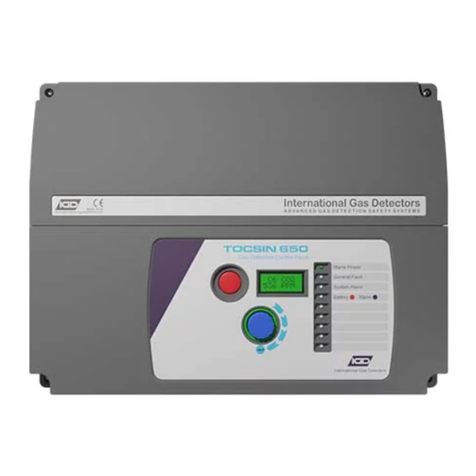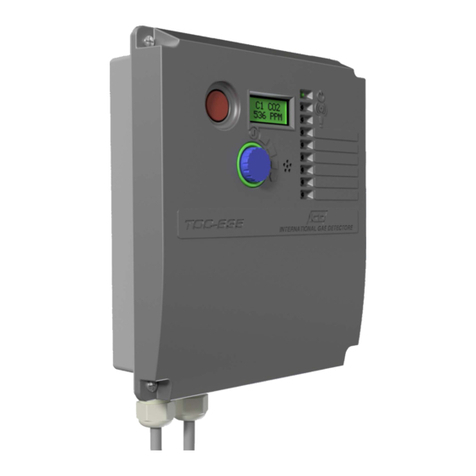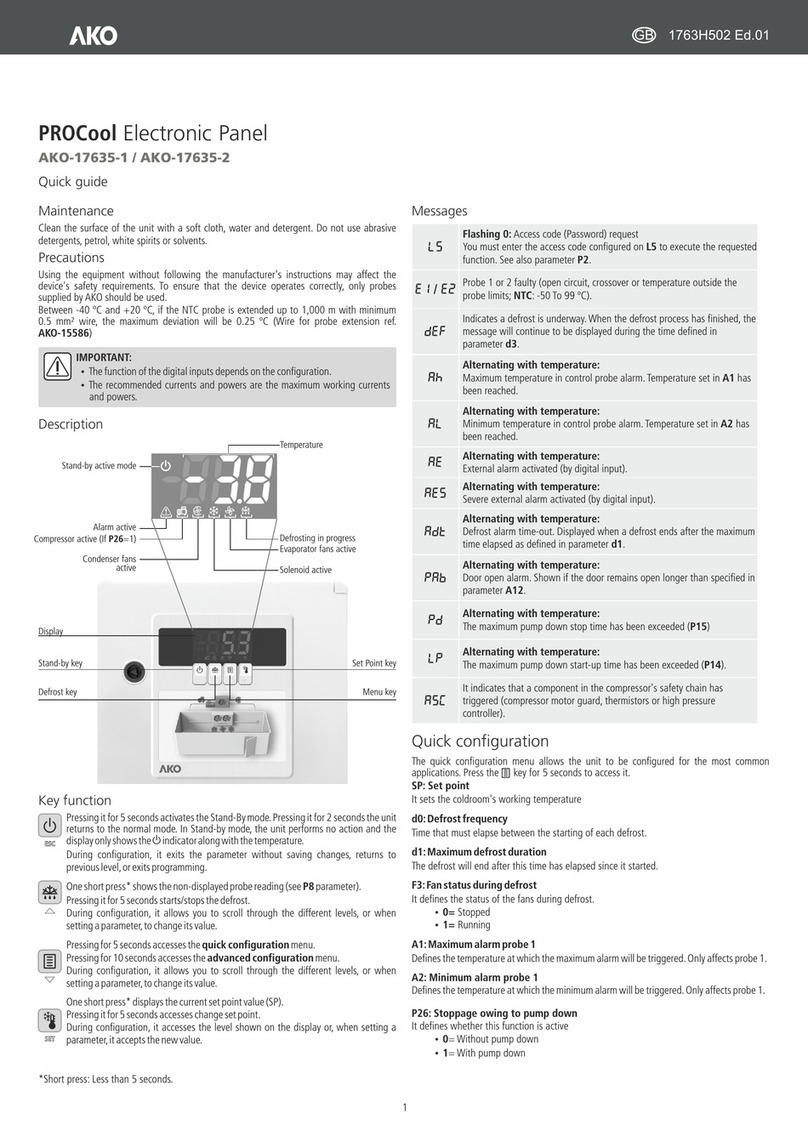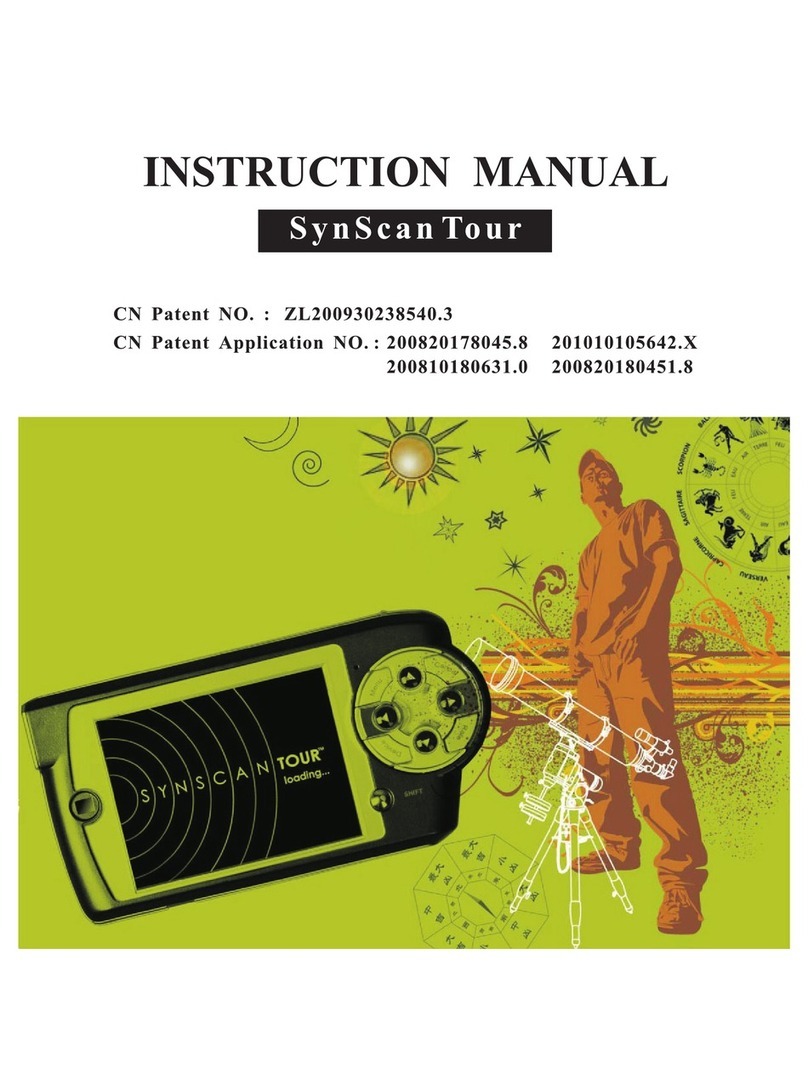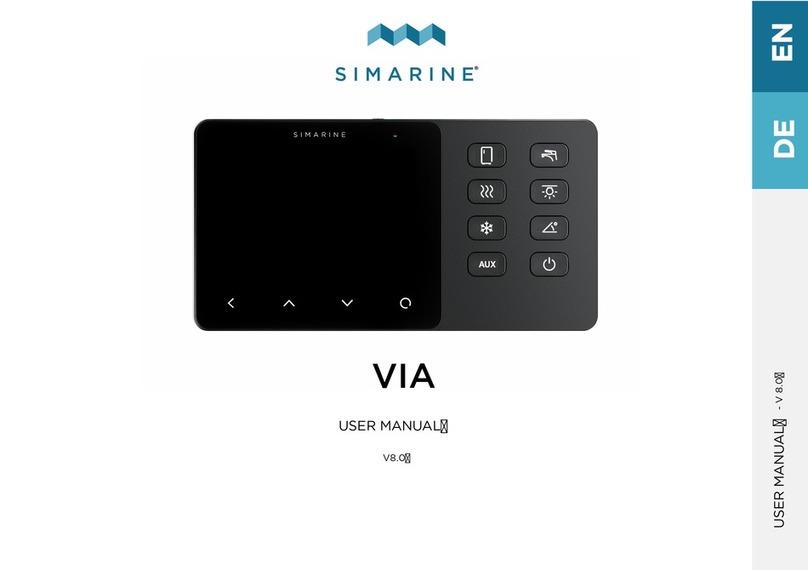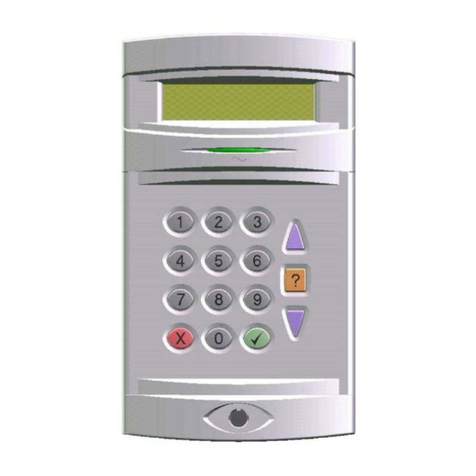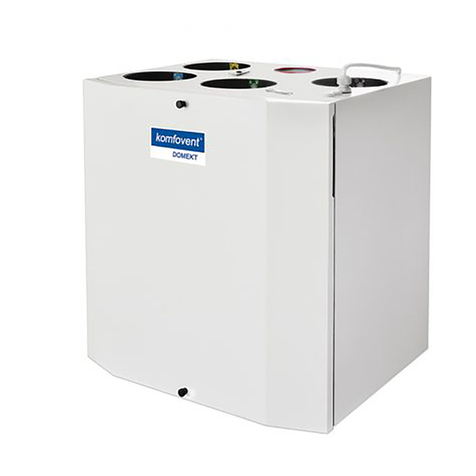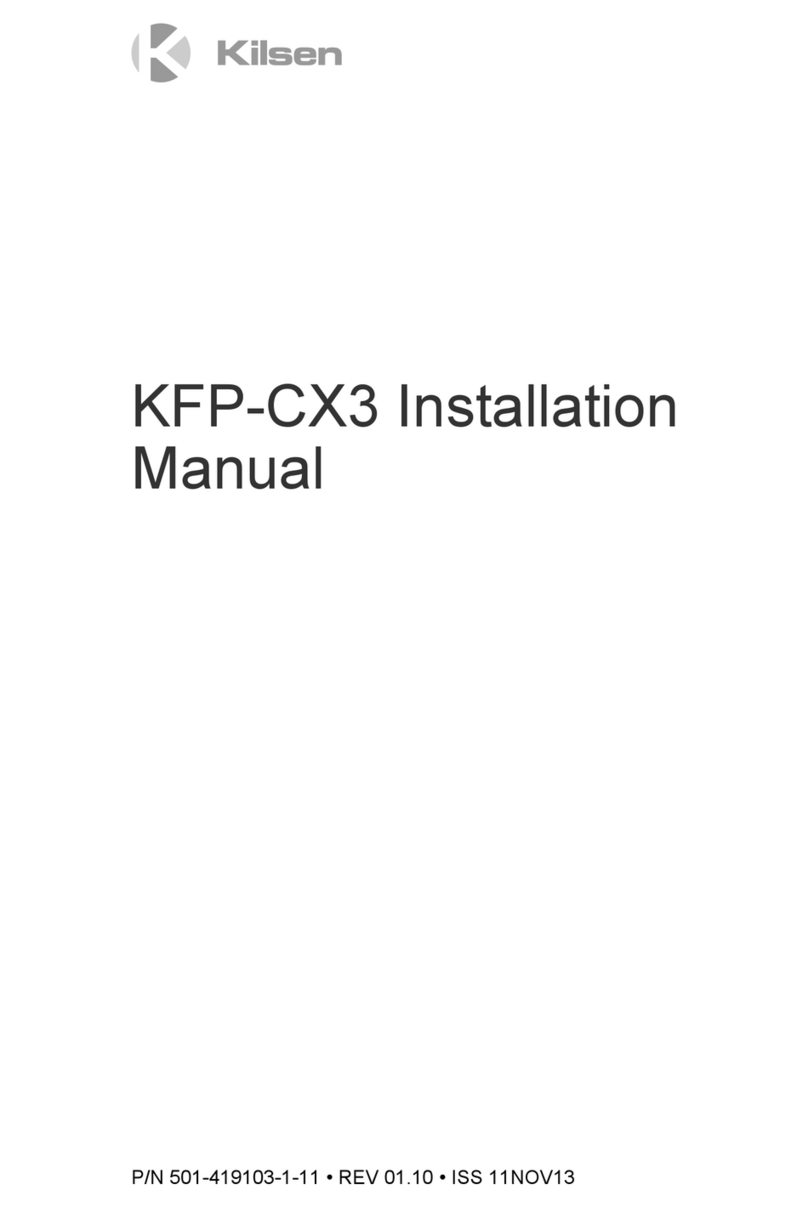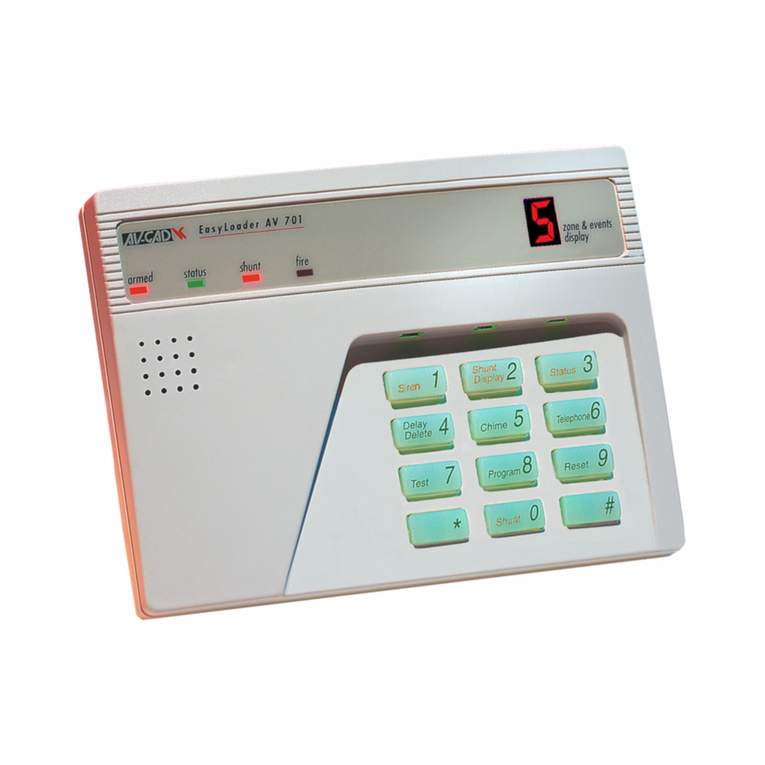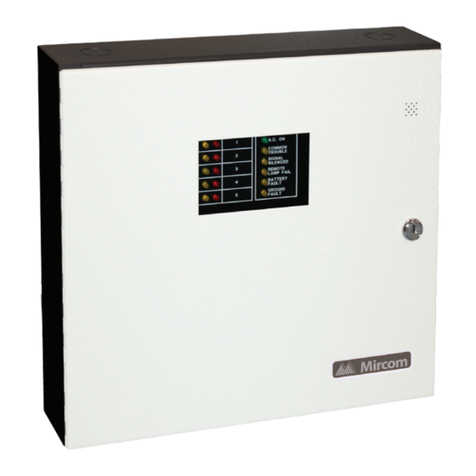IGD TOCSIN 750 Series Installation guide

1
TOC-750R-24
International Gas Detectors
Advanced Addressable Gas Detection System
ACCESS
KEY
TOCSIN 750 SERIES
H M I B a s e d D e t e c t o r C o n t r o l P a n e l
O p e r a t i o n a n d M a i n t e n a n c e
V 3 . 6 1
Triton House
Crosby Street
Stockport
SK2 6SH
England
Tel: +44 (0)161 483 1415
Fax: +44 (0) 161 484 2345
Email: [email protected]
Website: www.internationalgasdetectors.co.uk
FS646773
REF: 750M-7
EMS696504

2
Table of Contents
Specification
CE Declaration
Overall Dimensions
Interface Wiring
Operating System
4
5
8
10
11
13
14
16
17
18
19
20
21
22
24
22
23
25
26
26
27
29
30
31
32
33
34
35
36
37
39
Highway Hub Controller Overview
Relay Card Overview
Detector Node
Modbus
Overview
Special States
Alarm display Mode
Warmup - Inhibit
Fault States
System Menu's
Setup Sequence
Operational Set up Philosophy
Engineers Menu
System Menu - Access Options
Channel Setup Tab
Sensor FIND Function
Sensor Setup
Sensors Test Function
Sensor Diagnostics
The Relay Tab
Relay Comms Test Function
Relay Diagnostics Function
Relay Function Test
The Alarms Tab
The Alarm Relay Setup Menu
Calibration Menu Tab
The Sensor ZERO Function
The Sensor CALIBRATE Function
Connection Possibilities
Module PCB setup
Pellistor Settings and Module Options
T102 Settings and Module Options
I/O 1 and 2 Settings and Module Options
Relay Settings and Module Options
Display Settings and Module Options
Forcing a Channel Input
Backing UP Panel Setup Internally
Power Function
Modbus Settings
Troubleshooting
Standard Accessories Supplied
TOC-750R I-O Rack Layout
TOC-750R Connector/Controller Layout
Information Specific to 19” Rack Versions
GSM Functions
TOC-750R System Controller Overview
TOC-750R I-O Rack Overview
TOC-750 Connector Function Pin Outs
40
42
43
44
44
45
46
47
48
49
50
57
57
59
60
61
51
58
63
62
Module Setup Functions
Help Section

3
Brief Introduction
The Tocsin 750 and 650 series control panels use the latest technology 2-wire addressable
highways to control gas detectors and associated accessories. Providing an extremely flexible and
low cost solution.
Main Features
750 Series
Up to 350 Detectors and I/O Points
Internal or External Battery Backup
2 Core Cable Connection (No Polarity)
Colour Touch Screen
650 Series
Jog Wheel Interface
RGB Backlit Display
Service & Maintenance
It is recommended that control panels and all connected detectors are commissioned upon
installation and serviced every 6 months by an IGD trained technician. IGD can offer full training to
enable your staff to do the servicing or offer a competitive service from our fleet of service
engineers.
Warnings and Performance Statements
This product must be earthed in accordance with local safety regulations.
The Control Panel leaves the factory configured for the supply voltage stated on the customers order.
Standard options are indicated in the basic specifications on page 4
Should the control panel be used in conjunction with portable generating equipment, care should be
taken to ensure that the electrical supply is within the tolerance band described above.
° °
The control panel may be stored at temperatures between -25 C and 60 C. If stored at low
temperatures and then brought into a warmer environment care should be taken to ensure that
condensation does not form or enter critical electrical components, for example the power supply.
Allow 24 hours to stabilise extremes of temperature.
o
The Control Panel is designed to operate within specification for ambient temperature between 0 C
o
and 55 C, relative humidity up to 90% ( non-condensing ). Sensor specifications may differ.
Do not use a Control Panel for protection applications that has not been calibrated. If calibration seals
are missing from the control panel or have been tampered with or broken, then the control panel must
be re-calibrated and sealed by a trained engineer.
Substances and interfering gases can cause adverse effects on the performance or electrical safety of
the gas detection systems. Care should be taken to limit exposure to these poisoning substances, for
further advice and information contact head office
The response time of the entire system is determined by the time of response of all the parts of the
equipment within the gas detection system.
The relationship between the output signal and the gas concentration is linear, the control panel
interprets the signal and the gas level is displayed on the HMI or RGB backlit display. IGD hold
evidence of this linear performance which is available upon request.
We recommend users read the procedures described in BS EN 60079-29-2 for reference.

4
Basic Specification
Alternate Specifications Where Changed for 19” Rack 750R Option
150W PSU @ 230VAC Nominal
Ambient Operating Temperature
Ambient Operating Humidity
Protection
Display
Displayed Detector Resolution
(Range Dependant)
External Interface
Connected devices
CE Declaration
Pressure Limits
Warm up tim
Max Power Consumption
Air Velocity
EMC Compatibility
Interfaces
Power
Protection
190 to 260V AC 50/60Hz by selection
-20 to +55 Degrees Centigrade
20-90% RH Non-Condensing (see sensor data)
IP54
IP ratings do not imply that the equipment will detect gas during and after exposure to these conditions.
Calibration and maintenance may be required more frequently and should be assessed based upon exposure.
7" Full Colour Touch Screen 800 x 480
1% LEL
1%Vol
0.1% Vol
1 ppm
0.1ppm
Modbus
Up to 128 Devices on single hub max 350 input channels
including ancillary I/O ports
Full EC Declaration appears on Page 4
800 to 1200mBar (80 to 120kPa)
15 minutes (Systems with Oxygen Sensors) 5 Minutes
Standard
150 Watts
0-6M/S refer to installers guide for allowable orientation
see installer guide
Calibration and maintenance may be required more frequently and should be assessed based upon exposure.
IP ratings do not imply that the equipment will detect gas during and after exposure to these conditions.
IP42
24V DC
As standard TOC-750-xxx but with an additional I/O card
fitted as standard offering an extra:
8 off digital/4-20mA inputs
2 off Digital Inputs
8 off Single Pole Change Over Relays Rated at 4A

5
EC Declaration of Conformity
Declares that the product listed as:
TOCSIN 750
Addressable Gas Detection Control Panel
Issued by: Oliver IGD Limited, Stockport, SK2 6SH , United Kingdom
Signature: Declaration of Conformity in accordance with EN ISO/IEC 17050-1:2004
Name: Andrew J Collier M.I.O.D
Position: Managing Director Date: 1 November 2019 Declaration Ref: T750-DEC-3
Are in conformity with the provisions of the following European Directive(s) when installed, operated, serviced and maintained
in accordance with the installation and operating instructions contained in the product documentation.
And that the standards and/or technical specifications referenced below have been applied or considered.
2004/108/EC EMC Directive
2006/95/EC Low Voltage Equipment Directive (note not applicable to 24V DC Powered Versions)
EN 60079-29-1
EN 50271:2001
EN 61326-1:2012 Table 2
EN 50270
EN 60529
EN 60068-2-6
EN 60335-1
EN 61010
Technical File Reference
Gas Detectors, Performance Requirements for detectors flammable gases (including control
panels)
Electrical apparatus for the detection and measurement of combustible gases, toxic gases or
Oxygen: requirements and tests for apparatus using software and or digital technologies.
Excluding requirements for SIL
Electrical equipment for measurement, control and laboratory use. EMC requirements. General
requirements
Electromagnetic Compatibility electrical apparatus for the detection and measurement of
combustible gases, toxic gases or Oxygen
Ingress Protection Degrees of Protection Provided by enclosures
Environmental testing. Tests. Test Fc. Vibration (sinusoidal)
Electrical Safety General Requirements
Safety requirements for electrical equipment for measurement, control, and laboratory use.
General requirements
T750-TF9
Issuers name and address:
Oliver IGD Limited of
Triton House
Crosby St,
Stockport SK2 6SH
United Kingdom
Tested by:
SOCIETÀ DEL GRUPPO IMQ
AN IMQ GROUP COMPANY
via Quintiliano 43 20138
Milano
Italy www.imq.it
Oliver IGD Limited Operate an
Independently assessed ATEX/IECEX
QAN.
Quality Assurance Certificate Number
16PQAN0014
Quality Assurance Notification Number:
2585
Units 16-18 Abenbury Way,
Wrexham Industrial Estate,
Wrexham, LL13 9UZ
United Kingdom
Oliver IGD Limited operate an independently
assessed ISO9001:2015 Quality Management and
ISO14001:2015 Environmental Management System
Certificate Numbers
FS0646773 & EMS696504
BSI Assurance UK LTD,
London, W4 4AL
United Kingdom

6
System Example
LPG 0-100%LEL
SN:20235-1-1 ADD:4110
GAS DETECTOR
LPG 0-100%LEL
SN:20235-1-1 ADD:4110
GAS DETECTOR
LPG 0-100%LEL
SN:20235-1-1 ADD:4110
GAS DETECTOR
Controller in Supervisors Office
ATEX Zoned Area
Laboratory
Gas Bottle Store
Addressable
2-Wire
Mains Power
Mains Power
Power Booster
L1L1
L2L2
E
E
OUTIN
Screen or Drain Wire
Cable Highway
Note 2
Note 1
Note 3
Note 4
Note 7
Note 8
Note 6
Note 5
1 Controllers can have internal or external battery backup
2 System devices connect using 2 core cable, there is no
polarity requirement for the ‘highway cabling.
3 Use room status indicators to protect entry ways, these
can display selected detector values for the area
4 Both ATEX/IECEX rated and safe area devices are available
5 Detector nodes have I/O capability and can directly run
beacon sounders or input other 4-20mA signals
6 Use the built in detector node relays to control external
devices such as gas valves
7 Power modules are available for larger systems
8 Fit i/o cards on the same highway where control is required

7
Gas detection systems must be correctly specified, installed and maintained in order to be effective.
Anyone undertaking elements of this work should have access to the necessary equipment and be able
to demonstrate competence. This will usually mean having passed a training competency course.
International Gas Detectors run training courses for safety survey, specification , installation and
service aspects of hazardous gas detection systems. In addition IGD can supply test equipment and
calibration gases necessary to undertake this work.
Please the following points
1. A zero grade gas usually instrument air or Nitrogen and a suitable calibration gas mixture is required.
2. The correct gas adaptors must be used to apply gases to detectors when zeroing and calibrating.
Incorrect application of gases can affect calibration results
3. Use equipment and gases traceable to a national standard. Any calibration will only be as good as
the equipment and materials used.
4. IGD supply fixed flow regulators for use with IGD calibration gas bottles which supplies gas at
0.5L/Min
Important Notes
Panel Options
Part Number
TOC-750-150B
TOC-750-150
Description
110/230V AC Control Panel 150W PSU
Standard Features inluding
HMI Display 4 Relays, 4 Highways
4AH Internal Battery Backup
110/230V AC Control Panel 150W PSU
Standard Features inluding
HMI Display 4 Relays, 4 Highways
TOCSIN 750 Series Controller
TOCSIN 750 Series Annunciator
Options With:
Display, Relay Output, Digital or
Analogue Input, Flammable Gas Detector
TOCSIN 750 Series Detectors
Flammable Gases, Toxic Gases
Oxygen
TOCSIN 102 Series Detectors 2-WIRE
Flammable Gases, Toxic Gases
Oxygen For ATEX Applications

8
Tocsin 750 Physical
General
Installation Cables
FRONT VIEW
382mm
292mm
72mm
120.5mm
134mm
20mm
48.5mm
Front Face
Top Face
Side Face
56.5mm
30mm
10 off 20mm
Cable Entries
360mm
Supported Installation Cables 2 Core 1.5mmSQ or 2.5mmSQ See IGD Cable System Calculator
Typically SWA, MICC, FP200, SY, CY, System cables must be screened, refer to installers guide
Note 150W and 24V DC Versions Can be
Flush mounted into walls up to the front face flange
300W Versions have active ventilation and must be
surface mounted allowing 100mm clearance all round
Note that the rear case can be rotated to allow
20mm entries to face either up or down
Note cables run with modules sequentially wired.
Power can be taken from system modules for small current devices such as LED beacon sounders and is
limited to 100mA per module
Highways are fused at 2A, observe load calculations when planning, use boosters where necessary
Observe interface requirements for relays, fitting freewheel diodes and snubbers as indicated
End of line terminators, supplied with panels must be fitted for correct operation

9
Installation Guide
Your 750 Series control panel has been supplied with a separate installation guide. Please read this
before installing your system. The Installation guide provides information for correct cable selection,
how to correctly install cables and devices and ensure correct cable segregation. It is important to
read and understand this document prior to installation.
Copies of the installation guide are available in the downloads section of our website. Always check
you are using the latest versions of the supplied manuals by checking on the IGD website.
Failure to follow correct installation may result in poor performance and/or damage to system
components.
2-WIRE SYSTEMS
2 - W i r e G a s D e t e c t i o n S y s t e m I n s t a l l e r s G u i d e V x x
OL IVE R I G D
Triton House
Crosby Street
Stockport
SK2 6SH
England
Tel: +44 (0)161 483 1415
Fax: +44 (0) 161 484 2345
Email: [email protected]
Website: www.internationalgasdetectors.co.uk
Addressable
2-Wire
Version 2.0
T750-INST
International Gas Detectors
IGD-Academy
IGD’s On-Line training academy is available to support your companies activities. The Academy
features a range of CPD approved training courses and ‘how to’ videos.
The academy can be found at: https://igdacademy.internationalgasdetectors.com
Please note that some courses are only available on a request basis. If you require a request only
course please email to request your account and course.[email protected]

10
T750 Control Panel & 2 Wire Hub Controller PCB Features
Power in
24V DC
Battery Connection
For Battery Backup
Ethernet Rs485 Remote
(Modbus etc)
Display
Colour HMI
Display TOC-650 (2x8 LCD)
Fault Relay
Alarm Relay 1
Alarm Relay 2
Alarm Relay 3
Direct Beacon-Sounder O/P
Inputs for E-stops/Fire
4 off 2 Wire Ports Each supporting 32 Devices
128 Devices in Total
L1
L1
L1
L1
L2
L2
L2
L2
Notes

11
Tocsin 750 Addressable Relay Card Setting Relay Addresses
Press and hold the DOWN button until all LED's are OFF. Release the button
and the address currently set will be illuminated on the bottom five LED’s.
Use the UP and DOWN buttons to alter the address set as indicated in the
table below
To exit press and hold UP or DOWN button until all LED’s are off then release.
DOWN
BUTTON
UP
BUTTON
Each Addressable relay card must have its own unique base address. This can
be set on the card and is indicated below. The relays are then
addresses/numbered from that base address. The example below shows a card
with a default base address of 101
101
102
103
104
105
106
107
108
100
108
116
124
101
109
117
125
102
110
118
126
103
111
119
127
104
112
120
128
105
113
121
129
106
114
122
130
107
115
123
131
1 2 3 4 5 1 2 3 4 5
NOTE: WHEN SETTING ADDRESSES YOU CANNOT HAVE TWO DEVICE ADDRESSES SET THE
SAME ON THE SAME ADDRESSABLE HIGHWAY or DEVICE.

12
Tocsin 650/750 Addressable I/O Card Input Ports
4-20mA Signal
24V DC
0V DC
4-20mA Signal
24V DC
Loop Powered Detectors
3 Wire Detectors
Typical IGD Loop Powered
4-20mA Detectors
Temperature
Pressure
CO
H2S
Oxygen
HCN
HCL
NO
NO2
H2
CL
SiH4
O3
Typical IGD Loop Powered
4-20mA Detectors
Pellistors Based Detectors
Infra Red Based Detectors
PID Based Detectors
Thermal Conductivity
Relay cards also have analogue and digital inputs that can be used to read data onto the system
from external devices. Setup of the inputs, type, range, addressing etc is controlled via IGD’s
Android Apps. Wiring options are indicated below. Note the differences between Version 1 and 2
PCB assemblies.
Note 1
Note 2
Note 1
Note 2
Note 3
These Ports are designated to be digital inputs only.
These Ports are not used on version 1 PCB assemblies limiting the PCB to a maximum of 6
analogue inputs or 8 digital inputs including ports 9 and 10.
If extended 4-20mA devices are connected, they maybe floating ground type.
10
9
8
7
6
5
4
3
2
1

13
Tocsin 750 Addressable Detector Node
The following diagram indicates features available on the TOC-750 ‘module’ PCB. Please note
that failure to observe and make correct connections or exceed ratings may result in damage to
the PCB.
Ribbon Cable Connection For TOC-750
Annunciator Display and Options
Local LED Indications
And Up/Down Interface Buttons
Pellistor (Catalytic)
Flammable Gas
Detector Interface
Suitable for IGD
Types MK3, MK6, MK7
2-Wire Highway
Connection
To Next Device
Multi-Function I/O Port 1
Solid State Output or
4-20mA Input or
TOC-10 IP or Gas Meter
Multi-Function I/O Port 2
Solid State Output or
4-20mA Input or
TOC-10 IP or Gas Meter
Connection Point For
IGD Infra-Red, Toxic, PID
or Oxygen Gas Detectors
2-Wire Highway
Connection
To Next Device
P
Y
W
SPCO Relay
Output
DVM Test Point + DVM Test Point -
Housing
Sealing
Environment
Temperature
Voltage
Communication
Relay
Digital Output
Digital Input
Analogue I/P
Pellistor Port
Sounder
Display
Comm Port
1
2
3
4
5
6
7
TOC-750 Series ABS or Copper Free Aluminium For ATEX Versions
IP65 (using suitable glanding & splash guard) for TOC-750, IP68 for ATEX Versions
0 -95% RH Non Condensing
0-55 Deg C
12-28V DC
IGD 2-Wire Highway Operating IGD Sentinel+ Protocol
Not Polarity Dependant
5A Non Inductive Loads 230V AC
24V DC 100mA Combined For Both Outputs Typically for LED Beacon Sounders
Suitable for use with TOC-10 Link Function, switch/call point, totalising count
4-20mA, selectable range, units and tag information
Option to Interface to MK3, MK6 or MK7 Pellistors
85dB (Option for TOC-750 Annunciators)
2 x 8 Programmable LCD with RGB Backlight (Option for TOC-750 Annunciators)
Supports IGD Infra-Red, PID, Toxic and Oxygen Gas Detectors
Module PCB Basic Interface Specifications
2
7
5
6
4
3 3
11

14
B
A
0V DC
Screen
B
A
0V DC
RS485 Modbus
Comms Port
RS485 Modbus
Comms Port
Interfacing to the Remote Modbus Port
Tocsin 650/750 Controller (slave)
Master DCS/BMS
Note only the A,B and 0V DC Connections are
Used. 0V DC between master and slave should
be connected for correct operation and to prevent
damage to both master and slave systems
The Tocsin 640 controller has an in-built memory map allowing access to alarm status, panel status,
readings etc using Modbus RTU protocol. Wiring between units is as follows:
MODBUS INTERNAL MEMORY MAP ADDRESSES
COMMAND STRUCTURE
Parameter
Setting
1: Modbus Mode
RTU Mode Only
2: Operating Mode
Slave Mode Only
#1
3: Response Time
Maximum = 100mS
(5s for Zero Command)
4: Requests
Maximum = 32 per Second
5: Panel Address
100 to 131 (100=default)
6: Baud Rate
4800, 9600, 19200 (19200=default)
7: Start Bits
1
8: Data bits
8
9: Parity
None, Odd, Even
(Odd=default. None=T700 only)
10: Stop
1, 2 (1=default & T700 only)
11: Flow Control
None
12: Physical Interface
2 Wire RS232, 2 Wire RS485
(2 Wire RS485=Optional on T900)
13: Bit Order
Least significant bit transmitted first
14: Byte Order
Least significant byte transmitted first
15: Inter-byte spacing
Maximum = 1.5 bytes times
(781uS @ 19200 Baud)
16: Inter-packet spacing
Minimum = 3.5 bytes times
(1823uS @ 19200 Baud)

15
MODBUS INTERNAL MEMORY MAP ADDRESSES
FUNCTIONS:
Command
Function
Register
Sensor
Returned Word
Read Sensor Conc
04
30,001 to 30,999
1 to 999
Min = 0 (-10% LEL)
Max = 1200 (110% LEL)
Resolution = 0.1%
Read Sensor Volts
04
31,001 to 31,999
1 to 999
Min = 0 (0.00V)
Max = 500 (5.00V)
Resolution = 0.01V
Read Area Status
(T700 = Common
Alarms)
04
32,001 to 32,999
AREA
1 to 999
Bit0 = AL1
Bit1 = AL2
Bit2 = AL3
Bit3 = Fault
Bit4 = Sensor Disabled
Bit5 – Bit15 = Spare
Read Sensor Status
04
33,001 to 33,999
1 to 999
Bit0 = AL1
Bit1 = AL2
Bit2 = AL3
Bit3 = Fault
Bit4 = Sensor Disabled
Bit5 = Sensor Fault
Bit6 = Under Range Fault
Bit7 = Over Range Fault
Bit8 = Comms Fault
Bit9 = Spare
Bit10 = Spare
Bit11 = Spare
Bit12 = Spare
Bit13 = AL1 Muted
Bit14 = AL2 Muted
Bit15 = AL2 Muted
Mute all Alarms
05
1
ALL
Pass = 0
Fail = 1
Reset all Alarms
05
2
ALL
Pass = 0
Fail = 1
Disable Sensor
05
1,001 to 1,999
1 to 999
Pass = 0
Fail = 1
Enable Sensor
05
2,001 to 2,999
1 to 999
Pass = 0
Fail = 1
Zero Sensor
05
3,001 to 3,999
1 to 999
Pass = 0
Fail = 1
Set Add. Relay = On
05
4,201 to 4,232
4201 to
4232
Pass = 0 Fail = 1,2,3
(1=Timeout, 2=Already Used,
3=Not Implemented)
Set Add, Relay = Off
05
5,201 to 5,232
4201 to
4232
Pass = 0 Fail = 1,2,3
(1=Timeout, 2=Already Used,
3=Not Implemented)

16
Operating System
On powering of the system, there is an initial count down to allow detectors time to
stabilise. This period can be configured in the engineers menu options to suit particular
applications. During this warm up period all alarms are inactive.
After the countdown period the system goes into normal monitoring operation.
Click on a displayed channel number to make it the
currently viewed channel or type in the channel
number of interest. Note that the display centres on
the selected channel and displays its current status
Alarm 1 Level
Alarm 2 Level
Alarm 3 Level
Sensor TAG, alarm levels
and status displayed Bluetooth Enable/Disable
Gas Detector Type
Digital and Analogue
Readings
In General:
Green = Normal
Red = Alarm
Yellow = Fault
Black = Disabled

17
Special Status States
State
Warm up
Fault Communication
Fault Over Range
Fault Under Range
Fault Failed Self Test
Processor Voltage
Fault Failed Self Test
Flash Memory
Fault Failed Self Test
RAM
Alarm 1, 2, or 3 Active
Zero/Calibration
in Progress
Inhibit Controller
Output Test
Indication
On Screen Count Down ‘Blue’
Comms Error Displayed ‘Yellow’
Channel/Display Indication Yellow
Channel/Display Indication Yellow
On Screen Display Indication
Yellow
On Screen Display Indication
Yellow
On Screen Display Indication
Yellow
On-Screen Red
Alarm 1, 2, or 3 Active Display
Each Channel in Alarm
Calibration in Progress
On-Screen Blue
On-Screen Blue
State
Modbus State Available*
Fault Relay Normal
Alarm Relays Normal
Modbus State Available*
Fault Relay Active
Alarm Relays Normal
Modbus State Available*
Fault Relay Active
Alarm Relays Normal
Modbus State Available*
Fault Relay Active
Alarm Relays Normal
Modbus State Available*
Fault Relay Active
Alarm Relays Normal
Modbus State Available*
Fault Relay Active
Alarm Relays Normal
Modbus State Available*
Fault Relay Active
Alarm Relays Normal
Alarm Relay 1, 2, or 3 Active**
Modbus State Available*
Fault Relay Normal
Modbus State Available*
Fault Relay Normal
Alarm Relays Normal
Modbus State Available*
Fault Relay Normal
Alarm Relays Normal
Modbus State Available*
Fault Relay Normal
Alarm Relays Normal
* See Modbus information for available registers and options
** Alarm Relays can be setup via the controller software, see alarm options. Each channel on the
system will automatically have at the least an alarm level one. This is not optional
The following Pages indicate some of these special states and how they are displayed

18
System Display When in Alarm
when the system goes into alarm the display immediately
selects the first channel that went into alarm to be the
current channel. Note Alarms take precedence over any
system faults. An Amber FAULT indicator appears in the
event of any panel faults as indicated above.
The number of
active alarms is
displayed. Use
the left and right
keys to select
between
channels in
alarm.
If beacons and sounders are connected using detector nodes then the sounders can be muted.
Note that if alarms are set as latching there are also options to try and reset just this channel or all
channels that are in alarm. To reset a latching alarm you must be below the alarm level.
Bar Graph Alarm Level Indicators
Rising Latching Alarm Level
Note Latching Alarms Stay Active After The
Gas Level Has Gone and Must be Physically Reset
Falling Latching Alarm Level
Note Latching Alarms Stay Active After The
Gas Level Has Gone and Must be Physically Reset
Rising Alarm Level
Rising Alarms Automatically Reset
Themselves After The Gas Level Has Gone
Falling Alarm Level
(Typically for Oxygen Depletion Alerts)
Falling Alarms Automatically Reset Themselves After
The Gas Level Has Gone
Gas levels must exceed
an alarm level for the
alarm to become active. A
delay before alarm can be
set in the engineer menu
and is common in
ventilation applications to
introduce additional
hysteresis into a system.
Channel will Flash
Over Range if the
Measurement Range
is exceeded
FAULT
OVER RANGE
Fault Indicator

19
System Display During Stabilisation (Warm Up)
On initial power up the system will run a series of system checks and then start a stabilisation ‘warm
up’ timer. For systems including Oxygen sensors this will be 15 minutes, other sensor types 5 minutes.
During warm up alarm relays will be in their ‘normal’ non-alarm states. A modbus state is available to
indicate warm up status.
System Display With the System Inhibited for service
Entering Pass Code 25 will place the system into inhibit mode. Initially this will be for 60 minutes
and can be terminated by selecting cancel at any time. During inhibit mode the system is not
communicating to its detectors and so will not respond to them. Typically inhibit mode is used
during system maintenance when Android/tablet IGD service tools are being used.
Alarm and fault relays remain in their normal state during inhibit mode and a modbus state is
available to indicate the same.
If required a 2 hour period can be selected and it is also possible to enter engineer modes via
this menu with the system still inhibited.
After the countdown the system will revert to normal operation.

20
System Display During Fault Detected
State
Fault Communication
Fault Over Range
Fault Under Range
Fault Failed Self Test
Processor Voltage
Fault Failed Self Test
Flash Memory
Fault Failed Self Test
RAM
Indication
Comms Error Displayed ‘Yellow’
Channel/Display Indication Yellow
Channel/Display Indication Yellow
On Screen Display Indication
Yellow
On Screen Display Indication
Yellow
On Screen Display Indication
Yellow
State
Modbus State Available*
Fault Relay Active
Alarm Relays Normal
Modbus State Available*
Fault Relay Active
Alarm Relays Normal
Modbus State Available*
Fault Relay Active
Alarm Relays Normal
Modbus State Available*
Fault Relay Active
Alarm Relays Normal
Modbus State Available*
Fault Relay Active
Alarm Relays Normal
Modbus State Available*
Fault Relay Active
Alarm Relays Normal
Faults are indicated on screen as a ‘Yellow’ display. Faults will be indicated against either the system
or against the channel that has a fault. Alarms take precedence over faults but will still be indicated on
screen at the side of the main display panel. FAULT
Table of contents
Other IGD Control Panel manuals
Popular Control Panel manuals by other brands
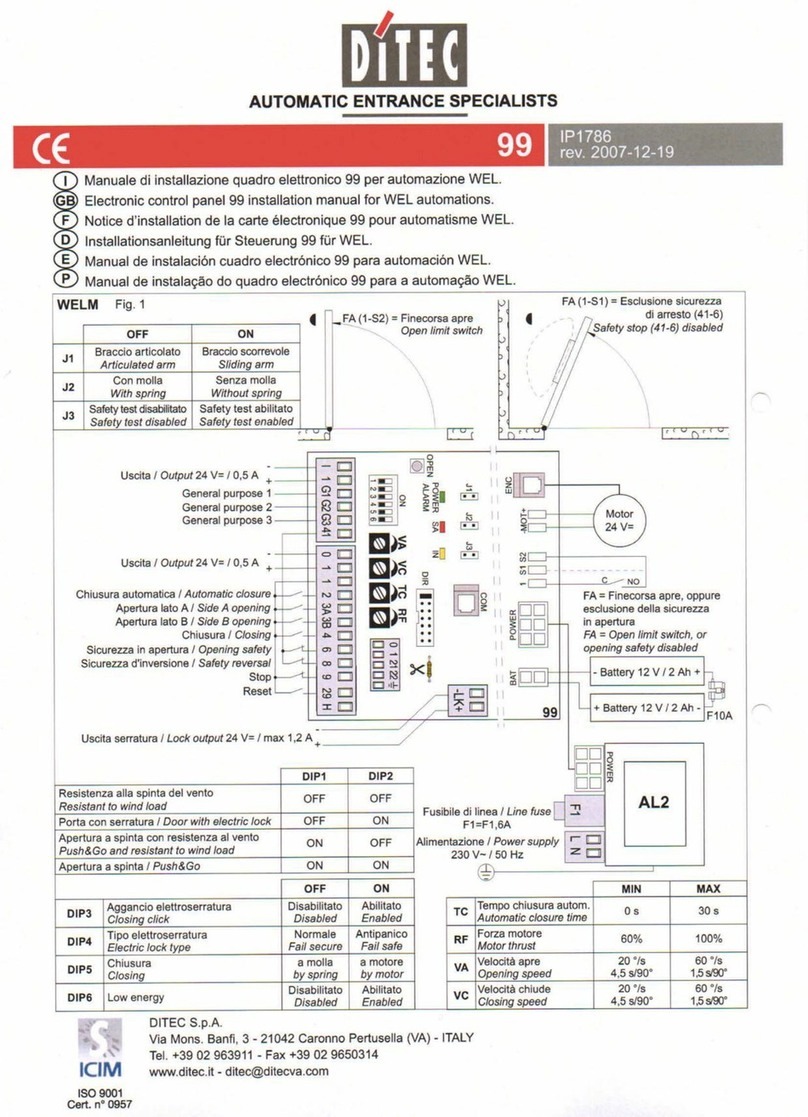
DITEC
DITEC 99 installation manual
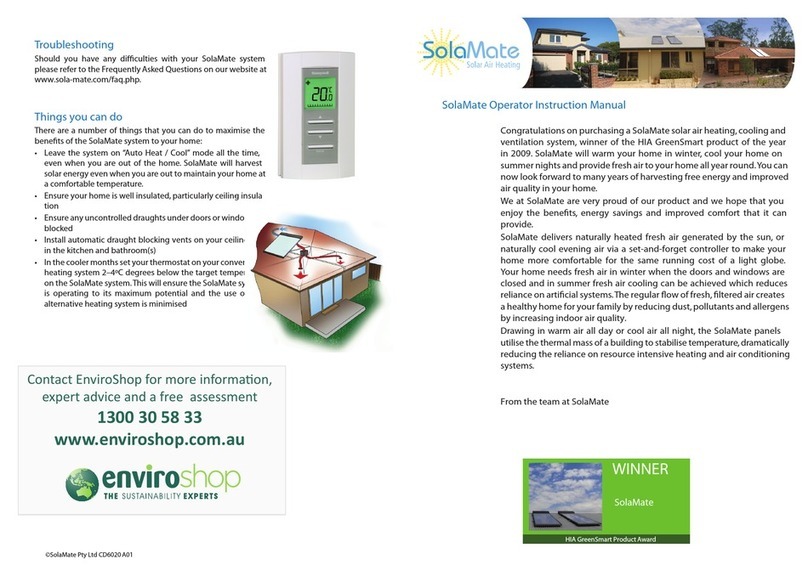
SolaMate
SolaMate Control Panel Operator's instruction manual

Fagor
Fagor 8040 TCO CNC operating manual
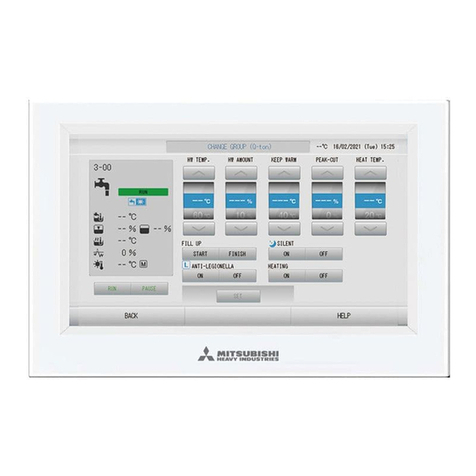
Mitsubishi Heavy Industries
Mitsubishi Heavy Industries SC-SL4-AE2/1 user manual
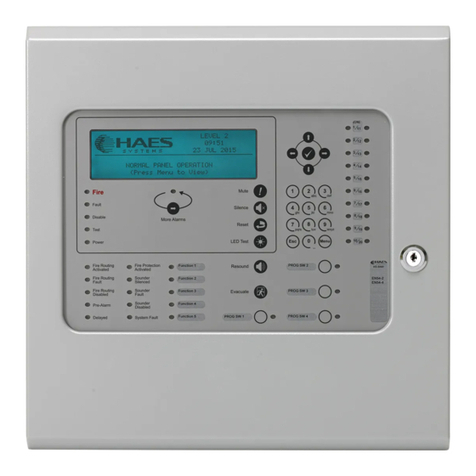
Haes
Haes ELAN HS-5200 Installation and programming manual
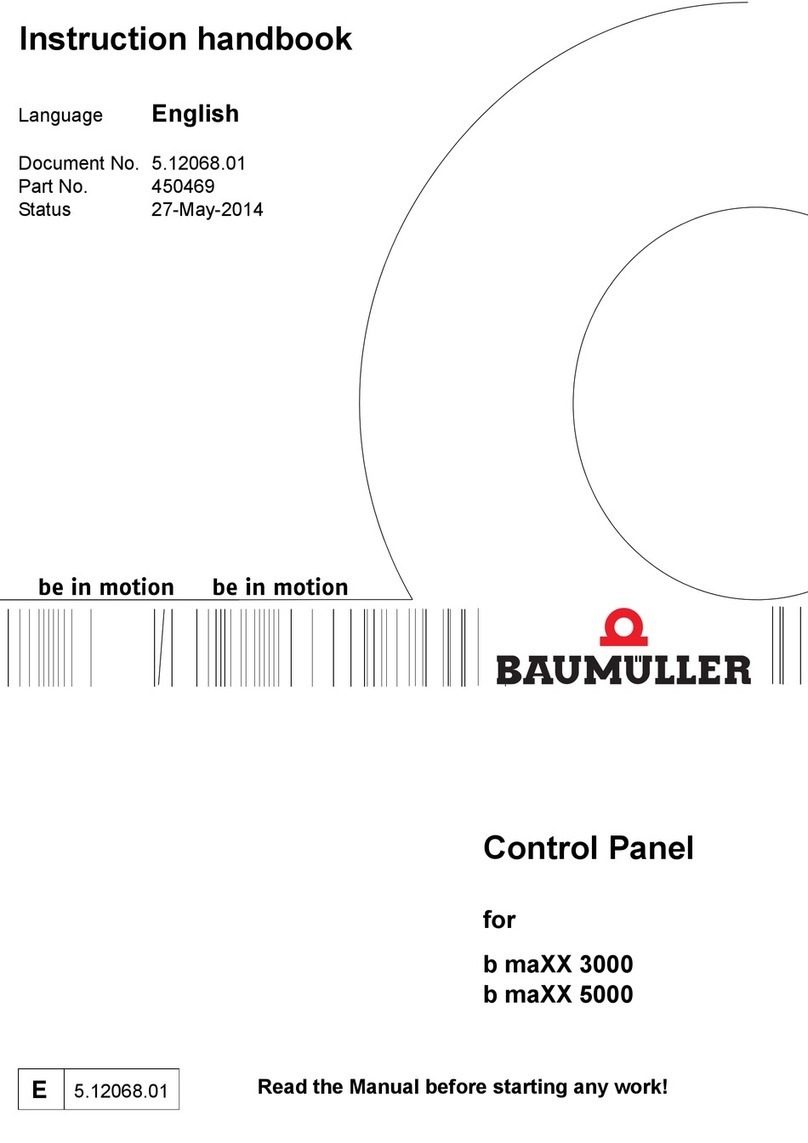
Baumuller
Baumuller b maXX 3000 Instruction handbook
